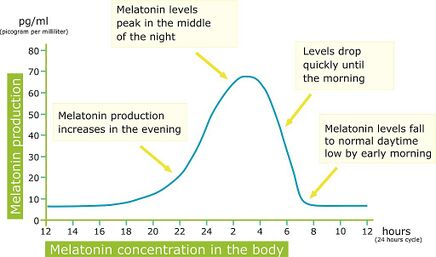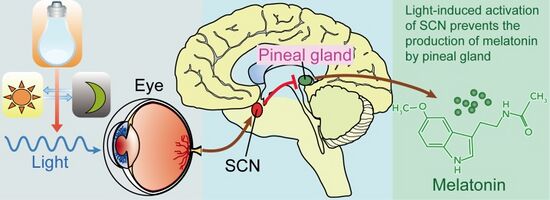Melatonin
Original Editor - Lucinda hampton
Top Contributors - Lucinda hampton and Vidya Acharya
Introduction[edit | edit source]
Melatonin, mostly released by the pineal gland, is a circadian rhythm-regulated and multifunctional hormone. Great advances in melatonin research have been made, including its role in rhythms of the sleep-wake cycle, retardation of ageing processes, as well as antioxidant or anti-inflammatory functions. Melatonin production gradually declines with age, and its loss is associated with several age-related diseases.[1]
Roles of Melatonin[edit | edit source]
Include:
- Melatonin plays a crucial role in regulating sleep cycles by detecting light and dark through the retina. Melatonin is sometimes called the “Dracula of hormones” because it only comes out in the dark.[2]
- Melatonin has antiaging properties and modulates immune system function.Melatonin is effective in reducing oxidative stress. It achieves this action through scavenging free radicals such as reactive oxygen species (ROS) and indirectly by stimulating antioxidant enzymes while suppressing the activity of pro-oxidant enzymes[3].
- Melatonin plays an important role in oocyte maturation, fertilization and embryonic development as well. It binds to its receptors on the pituitary gland and the ovaries and appears to regulate the release of female reproductive hormones. Additionally, in certain mammals (other than humans), for example horses and sheep, melatonin acts as a breeding and mating cue, being produced in greater amounts in response to the longer nights of winter and less so during summer.[4][5][1]
Synthesis of Endogenous Melatonin[edit | edit source]
The hormone melatonin is produced naturally, synthesized, and secreted mainly in the pineal gland. Melatonin production begins with tryptophan, which in a multistep process is converted to serotonin in other parts of the brain. Some serotonin made makes its way to the pineal gland and is converted to melatonin in a regularly, light-dependent process. Melatonin is released from the pineal gland into the third ventricle and from there into circulation.
The conversion of serotonin to melatonin is controlled by the hypothalamus's suprachiasmatic nucleus (SCN), whose job is to control the body's circadian rhythms. Information about current light conditions travels from the retina along the retinohypothalamic tract to the SCN. From here signals are sent through the sympathetic nervous system to the superior cervical ganglia, which innervates the pineal gland[6].
Sub Heading 3[edit | edit source]
Resources[edit | edit source]
- bulleted list
- x
or
- numbered list
- x
References[edit | edit source]
- ↑ 1.0 1.1 Britannica Melatonin Available:https://www.britannica.com/science/melatonin (accessed 9.8.2022)
- ↑ Byjus Melatonin hormone Available:https://byjus.com/biology/melatonin-hormone/ (accessed 9.8.2022)
- ↑ Reiter RJ, Mayo JC, Tan DX, Sainz RM, Alatorre‐Jimenez M, Qin L. Melatonin as an antioxidant: under promises but over delivers. Journal of pineal research. 2016 Oct;61(3):253-78. Available: https://pubmed.ncbi.nlm.nih.gov/27500468/(accessed 9.8.2022)
- ↑ Yong W, Ma H, Na M, Gao T, Zhang Y, Hao L, Yu H, Yang H, Deng X. Roles of melatonin in the field of reproductive medicine. Biomedicine & Pharmacotherapy. 2021 Dec 1;144:112001. Available: https://pubmed.ncbi.nlm.nih.gov/34624677/ (accessed 9.8.2022)
- ↑ Wójtowicz M, Jakiel G. Melatonin and its role in human reproduction. Ginekologia polska. 2002 Dec 1;73(12):1231-7. Available:https://pubmed.ncbi.nlm.nih.gov/12722474/ (accessed 9.8.2022)
- ↑ Savage RA, Zafar N, Yohannan S. Melatonin.[Updated 2021 Aug 15]. StatPearls. 2021. Available:https://www.ncbi.nlm.nih.gov/books/NBK534823/ (accessed 9.8.2022)








